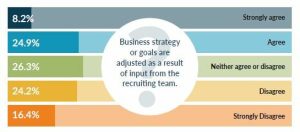In its quest to become strategic, talent acquisition has made slow progress. While a majority of recruiting teams and leaders meet regularly with senior management, that doesn’t mean they’re consulted on important decisions. Even when they are, their influence is so limited 4-in-10 say they exert none.
These stark findings come from a report released this morning by TLNT Research and underwritten by Bounty Jobs. Talent Acquisition’s Evolution to Strategic Business Partner details the results of a survey of HR and talent acquisition professionals, which asked about the role recruiting plays in business decisions. The TLNT survey found:
- Only 28% of organizations regularly consult their TA teams about important decisions. 39% rarely, if ever, do.

- Although 56% of respondents report TA and senior leaders meet at least monthly, less than half say management is “very informed” about recruiting initiatives.
- And only at 1-in-4 organizations do leaders consult with TA before making important decisions.
However, other, more positive results show that talent acquisition is making progress toward playing a strategic role. For example,
- A third of all respondents agree that business strategy or goals are adjusted as a result of recruiting’s input.
- Four-in-10 survey participants report that where they work, TA plays a “critical role” in brand awareness and reputation, and in revenue growth.
- And, to look at a previous data point differently, half of the survey respondents say leaders at least sometimes consult with their TA teams.
While the survey provides a look at where TA is today — perhaps the first detailed benchmarking of the strategic role of talent acquisition — the survey is only a portion of the overall report. One key sections discusses what it means to be strategic and how to get there. In an interview with the head of TA Strategy for an international pharmaceutical firm, the guidance is that recruiting has to start on the road by working among its own team. Don’t force everyone into a “strategy role.” And don’t accept “filtered down” information from business leaders.
Another section focuses on the key pressures that are driving the transformation of talent acquisition. Some are obvious: the talent shortage, competitive business pressures and the increasing use of contingent workers. Others are less obvious — communication, for example, especially when it comes to providing data to hiring managers.
The report also looks at some of the roadblocks in recruiting’s transformation. Recruiting budgets for 1-in-5 organizations hasn’t changed since 2015; for 15% it has gone down. A second and potentially even more significant issue is how recruiter performance is measured. Among the top 5 metrics, the only one arguably related to business strategy is quality of hire; it was cited by just under half the survey takers. 70% of respondents said their top performance measure was time to fill.
